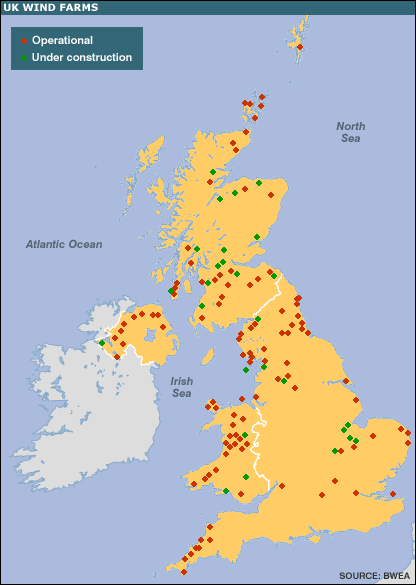
Wind power 'ahead of predictions'
Mar 27, 2006 BBC News
 Onshore
wind farms will provide about 5% of Britain's electricity
by 2010, according to the British Wind Energy Association
(BWEA). Onshore
wind farms will provide about 5% of Britain's electricity
by 2010, according to the British Wind Energy Association
(BWEA).
In a new report, it says turbines are being installed
faster than predicted.
If this is correct, onshore wind farms will take
the government halfway to its target of generating
10% of electricity from renewable sources by 2010.
The report comes a day before the government unveils
a major review of its climate change policies.
Entitled Onshore Wind: Powering Ahead, the report
claims to be the most comprehensive assessment of
the UK's onshore wind sector ever undertaken.
It forms part of the BWEA's response to another
ongoing government review on energy which is due
to conclude in the middle of the year.
Half full
| |
Our research
proves that onshore wind will bring major benefits
to the economy and the environment
Chris Tomlinson
|
The BWEA says that projects already
constructed and those already approved will give a
capacity of 3,000 megawatts (MW) by 2010.
Taking into account potential barriers such as
planning consent and grid capability, it identifies
a further 3,000MW capacity which it says is "forecast
to be consented and built" by the decade's end.
"Onshore wind can play a hugely significant role
in meeting renewable energy and climate change targets,"
said the BWEA's head of onshore, Chris Tomlinson.
"Our research proves, very clearly, that onshore
wind will deliver, bringing major benefits to the
economy and the environment while securing our energy
supplies."
Onshore wind farms are more advanced
than any other renewable energy sector in Britain,
though installation lags well behind some other European
countries such as Denmark and Germany.
A 2004 reform of the planning process aimed at
easing approvals has proven only a partial success,
with a number of recent applications refused or
scaled down.
But despite opposition from a few high-profile
figures such as TV naturalist David Bellamy, polls
suggest the public approves, with a Guardian/ICM
survey in 2005 showing about 70% of the population
endorsing wind farm construction within 20 miles
(32km) of their home.
If the onshore wind industry is as healthy as
the new report suggests, the challenge for the government
is to stimulate the remaining 5% of renewable capacity
needed to reach its 2010 target.
BWEA figures show that only four offshore wind
farms are currently in operation. Though output
can be higher per turbine and wind more consistent,
construction costs are also higher and grid connection
is a bigger issue.
Photovoltaic solar panels produce less than 1%
of the nation's electricity, and wave and tidal
technologies remain in the development stage.

|